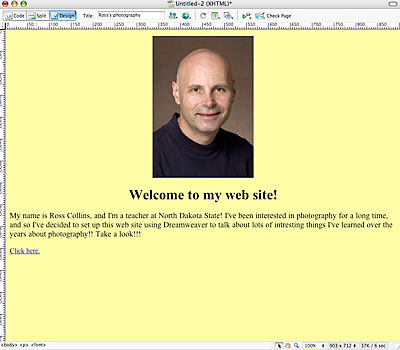COMM 750, Web Studies/Digital Media
Instructor: Ross Collins
Writing for the web: best practices
Good writing on the web is an exception. Perhaps that's because many webmasters have little formal training in writing for a "mass media" audience. Perhaps it's because webmasters are so taken with the web's other capabilities that plain old text seems boring. Yet most of what people do on the web is read text.
Attracting readers/users to our web sites is even more of a challenge than attracting them to paper-based publications. If your web site isn't compelling, users can probably find a thousand others waiting for a chance--and that Back Button is only too easy to use.
 Even users who do stay on your site will find reading more taxing than reading print, because screen resolution is not as sharp as ink on paper. So people tend to read differently on the web: they're impatient, they scan. How do webmasters cope? Here are some general guidelines based on usability studies such as those published by web usability expert Jakob Nielsen.
Even users who do stay on your site will find reading more taxing than reading print, because screen resolution is not as sharp as ink on paper. So people tend to read differently on the web: they're impatient, they scan. How do webmasters cope? Here are some general guidelines based on usability studies such as those published by web usability expert Jakob Nielsen.
At right is an example of a borrrrring home page. The "Welcome" heading was already old in 1997, and the copy is uninspiring, despite the multiple exclamation !!! points. Who wants to see my mugshot on a home page? "Click here" is no longer necessary--we can usually figure out links, and why center everything?
1. Document should be short, 700-1,000 words.
- Eliminate "word clutter" by re-reading drafts.
- Break longer documents into several linked web pages.
- People don't like to scroll.
2. Consider audience.
- Write in a tone appropriate for site purpose.
3. Be direct.
- Usability research shows web users prefer objective, fact-based sites.
4. Use headings/subheadings
5. Keep paragraphs short.
- Short sentences, about 50 words per graf.
6. Consider writing in "inverted pyramid style."
- Research shows people want information quickly.
7. Avoid "ad-speak."
- Research shows people don't like superlatives ("best ever!") on the web.
What do journalists need to know in a converged world? An introduction by Suzanne Levinson, director of site operations, Miami Herald (YouTube Video).
 Even users who do stay on your site will find reading more taxing than reading print, because screen resolution is not as sharp as ink on paper. So people tend to read differently on the web: they're impatient, they scan. How do webmasters cope? Here are some general guidelines based on usability studies such as those published by web usability expert Jakob Nielsen.
Even users who do stay on your site will find reading more taxing than reading print, because screen resolution is not as sharp as ink on paper. So people tend to read differently on the web: they're impatient, they scan. How do webmasters cope? Here are some general guidelines based on usability studies such as those published by web usability expert Jakob Nielsen.